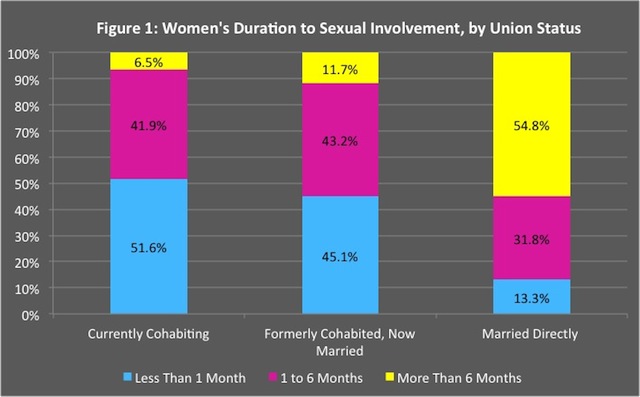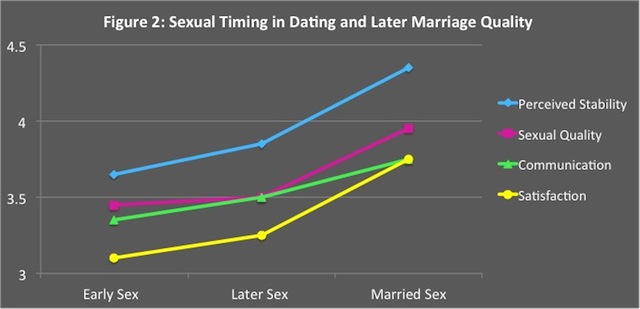Highlights
Is it better to assess sexual compatibility early in dating or to delay having sex? Does “true love wait” or should you “test drive” a relationship before saying I do? These are important questions to ask since most single adults report that they desire to one day have a successful, lifelong marriage—and while dating, many couples move rapidly into sexual relationships. In fact, as noted in Figure 1, recent studies have found that between 30 and 40% of dating and married couples report having sex within one month of the start of their relationship, and the numbers are even higher for currently cohabiting couples.

Source: Adapted from Sassler, S., Addo, F. R., & Lichter, D. T. (2012). The Tempo of Sexual Activity and Later Relationship Quality. Journal of Marriage and Family, 74, 708-725.
Note: Data are from the Marital and Relationship Survey. See Figure 1 in Sassler et al. (2012) for full details of these analyses.
Are these dating patterns compatible with the desire to have a loving and lasting marriage later? Let’s take a look at what research tells us about these questions.
Sexual Chemistry vs. Sexual Restraint
The current dating culture often emphasizes that two people should test their “sexual chemistry” before committing to each other. This type of compatibility is frequently mentioned as an essential characteristic for people to seek out in romantic relationships, particularly ones that could lead to marriage. Couples who do not test their sexual chemistry prior to the commitments of exclusivity, engagement, and marriage are often seen as putting themselves at risk of getting into a relationship that will not satisfy them in the future—thus increasing their probability of later marital dissatisfaction and divorce.
However, two recently published studies call into question the validity of testing sexual chemistry early in dating.
The longer a dating couple waits to have sex, the better their relationship is after marriage.
My colleagues and I published the first study a few years ago in the American Psychological Association’s Journal of Family Psychology. This study involved a national sample of 2,035 married individuals who participated in the popular online couple assessment survey called “RELATE.” We found that the longer a dating couple waits to have sex, the better their relationship is after marriage. In fact, couples who wait until marriage to have sex report higher relationship satisfaction (20% higher), better communication patterns (12% better), less consideration of divorce (22% lower), and better sexual quality (15% better) than those who started having sex early in their dating (see Figure 2). For couples in between—those that became sexually involved later in their dating, but prior to marriage—the benefits were about half as strong.

Source: Adapted from Busby, Carroll, and Willoughby (2010). Compatibility or restraint? The effects of sexual timing on marriage relationships. Journal of Family Psychology, 24, 766 – 774.
Note: Figure depicts mean scores reported by spouses in three sexual timing groups on relationship satisfaction, perceived relationship stability, sexual quality, and communication. To compare these three groups, the authors conducted a Multivariate Analysis of Covariance controlling for religiosity, relationship length, education, and the number of sexual partners. The results from the MANCOVA indicated that Sexual Timing Group and Gender had a significant effect on the dependent variables while holding the control variables constant. The means displayed here demonstrate that the Sexual Timing Group that participants belonged to had the strongest association with Perceived Relationship Stability and Satisfaction as all three groups were significantly different from each other. In other words, the longer participants waited to be sexual, the more stable and satisfying their relationships were once they were married. Gender had a relatively small influence on the dependent variables. For the other dependent variables, the participants who waited to be sexual until after marriage had significantly higher levels of communication and sexual quality compared to the other two sexual timing groups. See Table 3 in Busby et al. (2010) for full details of these analyses.
These patterns were statistically significant even when controlling for a variety of other variables such as respondents’ number of prior sexual partners, education levels, religiosity, and relationship length.
The second study, by Sharon Sassler and her colleagues at Cornell University, also found that rapid sexual involvement has adverse long-term implications for relationship quality. Using data from the Marital and Relationship Survey, which provides information on nearly 600 low- to moderate-income couples living with minor children, their study examined the tempo of sexual intimacy and subsequent relationship quality in a sample of married and cohabiting men and women. Their analyses also suggest that delaying sexual involvement is associated with higher relationship quality across several dimensions.
They discovered that the negative association between sexual timing and relationship quality is largely driven by a link between early sex and cohabitation. Specifically, sexual involvement early in a romantic relationship is associated with an increased likelihood of moving more quickly into living together, which in turn is associated with lower relationship quality. This finding supports Norval Glenn’s hypothesis that sexual involvement may lead to unhealthy emotional entanglements that make ending a bad relationship difficult. As Sassler and her colleagues concluded, “Adequate time is required for romantic relationships to develop in a healthy way. In contrast, relationships that move too quickly, without adequate discussion of the goals and long-term desires of each partner, may be insufficiently committed and therefore result in relationship distress, especially if one partner is more committed than the other” (p. 710).
So, why might sexual restraint benefit couples during dating and later in marriage? Evidence points to two primary explanations for why couples benefit from waiting to become sexually involved: intentional partner selection and sexual symbolism.
Intentional Partner Selection
A primary reason why sexual restraint benefits couples is that it facilitates intentional partner selection. Simply put, you have a better chance of making good decisions in dating when you have not become sexually involved with your dating partner. Leading marriage expert Scott Stanley, a frequent contributor to this blog, has proposed a concept of dating that he calls “relationship inertia.” The central idea of inertia is that some couples end up married partly because they become “prematurely entangled” in a sexual relationship prior to making the decision to be committed to one another—and had they not become so entangled early on, they would not have married each other. Inertia means that it is hard for some couples to veer from the path they are on, even when doing so would be wise; the fact that they share friends, an apartment, and maybe a pet make breaking up with each other even more difficult than it would otherwise be, and so the relationship progresses from cohabitation to marriage even if the partners are not very well matched.
A primary reason why sexual restraint benefits couples is that it facilitates intentional partner selection.
For many young adults, the single life has become synonymous with hook-ups and sexual experimentation. The problem with these patterns is that proper partner selection is often difficult for sexually involved couples who experience strong physical rewards with each other, as these rewards can cause them to ignore or minimize deeper incompatibilities in the relationship. The human brain and body do not just experience pleasure during sex; they also experience strong sensations of attachment and bonding. Simply put, we are hardwired to connect. Rapid sexual initiation often creates poor partner selection because intense feelings of pleasure and attachment can be confused for true intimacy and lasting love. Early sex creates a sort of counterfeit intimacy that makes two people think they are closer to each other than they really are. This can cause people to “fall in love” with, and possibly even marry, someone who is not a good choice for them in the long run.
Sexual Symbolism and Lasting Love
Sexual restraint also benefits couples because it requires partners to prioritize communication and commitment as the foundation of their attraction to each other. This gives couples a different type of foundation from couples who build their relationship on physical attraction and sexual gratification. This difference becomes particularly critical as couples naturally move past an initial period of intense attraction and excitement into a relationship more characterized by companionship and partnership. As Dr. Mark Regnerus, author of Premarital Sex in America, explains, “couples who hit the honeymoon too early—that is, prioritize sex promptly at the outset of the relationship—often find their relationship underdeveloped when it comes to qualities that make relationships stable and spouses reliable and trustworthy.” Couples who have sex early in their relationship are at risk of developing lopsided commitment levels (i.e., the woman is more committed than the man), less healthy communication patterns, and less ability to manage differences and conflict.
Sexual restraint allows couples to focus on and evaluate the emotional aspects of their relationship.
The value of sexual restraint for committed couples moving toward marriage is best understood when couples appreciate that emotional intimacy is the true foundation of sexual intimacy in a healthy marriage. Emotional intimacy exists in a relationship when two people experience a sense of security, support, trust, comfort, and safety with one another. In dating, focusing on emotional intimacy is a process of coming to know each other from the inside-out, not just the outside in. Sexual restraint allows couples to focus on and evaluate the emotional aspects of their relationship.
By gaining a deeper understanding of emotional intimacy, dating couples can more fully appreciate the principle of sexual symbolism. Ultimately, loving and lasting marriages are ones where the sexual intimacy is a meaningful physical symbol of the emotional intimacy shared between the spouses. Without this, sex is just physical and lacks the meaning needed to be truly satisfying over the long term. In dating, couples who hope to marry should focus on developing a foundation of friendship and communication that will serve as the ongoing foundation for sexual intimacy in their marriage. By practicing sexual restraint, couples allow themselves to focus on a true foundation of intimacy: acceptance, understanding, partnership, and love.
So, while true love does indeed wait, it may actually work the other way around: waiting helps create true love.
Jason S. Carroll, Ph.D., is a professor in the School of Family Life at Brigham Young University. Recently, Dr. Carroll received the Berscheid-Hatfield Award for Distinguished Mid-Career Achievement, a biennial award given for distinguished scientific achievement by the International Association for Relationship Research.










